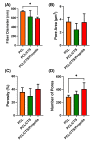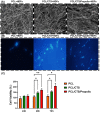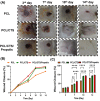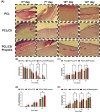Preparation and evaluation of a polycaprolactone/chitosan/propolis fibrous nanocomposite scaffold as a tissue engineering skin substitute
- PMID: 37645024
- PMCID: PMC10460768
- DOI: 10.34172/bi.2023.26317
Preparation and evaluation of a polycaprolactone/chitosan/propolis fibrous nanocomposite scaffold as a tissue engineering skin substitute
Abstract
Introduction: Recently, the application of nanofibrous mats for dressing skin wounds has received great attention. In this study, we aimed to fabricate and characterize an electrospun nanofibrous mat containing polycaprolactone (PCL), chitosan (CTS), and propolis for use as a tissue-engineered skin substitute.
Methods: Raw propolis was extracted, and its phenolic and flavonoid contents were measured. The physiochemical and biological properties of the fabricated mats, including PCL, PCL/CTS, and PCL/CTS/Propolis were evaluated by scanning electron microscopy (SEM), atomic force microscopy (AFM), mechanical analysis, swelling and degradation behaviors, contact angle measurement, cell attachment, DAPI staining, and MTT assay. On the other hand, the drug release pattern of propolis from the PCL/CTS/Propolis scaffold was determined. A deep second-degree burn wound model was induced in rats to investigate wound healing using macroscopical and histopathological evaluations.
Results: The results revealed that the propolis extract contained high amounts of phenolic and flavonoid compounds. The fabricated scaffold had suitable physicochemical and mechanical properties. Uniform, bead-free, and well-branched fibers were observed in SEM images of mats. AFM analysis indicated that the addition of CTS and propolis to PCL elevated the surface roughness. MTT results revealed that the electrospun PCL/CTS/Propolis mat was biocompatible. The presence of fibroblast cells on the PCL/CTS/Propolis mats was confirmed by DAPI staining and SEM images. Also, propolis was sustainably released from the PCL/CTS/Propolis mat. The animal study revealed that addition of propolis significantly improved wound healing.
Conclusion: The nanofibrous PCL/CTS/Propolis mat can be applied as a tissue-engineered skin substitute for healing cutaneous wounds, such as burn wounds.
Keywords: Chitosan; Nanofibers; Polycaprolactone; Propolis; Skin substitutes; Wound healing.
© 2023 The Author(s).
Conflict of interest statement
Authors declare all relevant interests that could be perceived as conflicting.
Figures
Similar articles
-
Fabrication and evaluation of the regenerative effect of a polycaprolactone/chitosan nanofibrous scaffold containing bentonite nanoparticles in a rat model of deep second-degree burn injury.Iran J Basic Med Sci. 2024;27(2):223-232. doi: 10.22038/IJBMS.2023.69930.15210. Iran J Basic Med Sci. 2024. PMID: 38234665 Free PMC article.
-
Antibacterial and antioxidant assessment of cellulose acetate/polycaprolactone nanofibrous mats impregnated with propolis.Int J Biol Macromol. 2019 Nov 1;140:1260-1268. doi: 10.1016/j.ijbiomac.2019.08.207. Epub 2019 Aug 28. Int J Biol Macromol. 2019. PMID: 31472212
-
An in vitro and in vivo study of PCL/chitosan electrospun mat on polyurethane/propolis foam as a bilayer wound dressing.Mater Sci Eng C Mater Biol Appl. 2022 Apr;135:112667. doi: 10.1016/j.msec.2022.112667. Epub 2022 Jan 19. Mater Sci Eng C Mater Biol Appl. 2022. PMID: 35577687
-
Preparation and evaluation of polycaprolactone/chitosan/Jaft biocompatible nanofibers as a burn wound dressing.Burns. 2022 Nov;48(7):1690-1705. doi: 10.1016/j.burns.2021.12.009. Epub 2021 Dec 23. Burns. 2022. PMID: 34973854
-
Characterization and in vitro evaluation of electrospun chitosan/polycaprolactone blend fibrous mat for skin tissue engineering.J Mater Sci Mater Med. 2015 Jan;26(1):5352. doi: 10.1007/s10856-014-5352-8. Epub 2015 Jan 13. J Mater Sci Mater Med. 2015. PMID: 25578706
Cited by
-
The wound healing effect of polycaprolactone-chitosan scaffold coated with a gel containing Zataria multiflora Boiss. volatile oil nanoemulsions.BMC Complement Med Ther. 2024 Jan 25;24(1):56. doi: 10.1186/s12906-024-04352-1. BMC Complement Med Ther. 2024. PMID: 38273247 Free PMC article.
-
Trends in the Incorporation of Antiseptics into Natural Polymer-Based Nanofibrous Mats.Polymers (Basel). 2024 Feb 29;16(5):664. doi: 10.3390/polym16050664. Polymers (Basel). 2024. PMID: 38475347 Free PMC article. Review.
-
Healing Effect of Hypericum perforatum in Burn Injuries.World J Plast Surg. 2024;13(3):57-65. doi: 10.61186/wjps.13.3.57. World J Plast Surg. 2024. PMID: 39665012 Free PMC article.
-
Network Pharmacology and Experimental Validation Reveal Therapeutic Potential of Propolis in UV-Induced Allergic Dermatitis.Foods. 2025 Mar 14;14(6):996. doi: 10.3390/foods14060996. Foods. 2025. PMID: 40232010 Free PMC article.
-
Fabrication and evaluation of the regenerative effect of a polycaprolactone/chitosan nanofibrous scaffold containing bentonite nanoparticles in a rat model of deep second-degree burn injury.Iran J Basic Med Sci. 2024;27(2):223-232. doi: 10.22038/IJBMS.2023.69930.15210. Iran J Basic Med Sci. 2024. PMID: 38234665 Free PMC article.
References
-
- Bacakova L, Zikmundova M, Pajorova J, Broz A, Filova E, Blanquer A, et al. Nanofibrous scaffolds for skin tissue engineering and wound healing based on synthetic polymers. In: Applications of Nanobiotechnology. IntechOpen; 2020. 10.5772/intechopen.88744. - DOI
-
- Augustine R, Dominic EA, Reju I, Kaimal B, Kalarikkal N, Thomas S. Electrospun poly(epsilon-caprolactone)-based skin substitutes: In vivo evaluation of wound healing and the mechanism of cell proliferation. J Biomed Mater Res B Appl Biomater. 2015;103:1445–54. doi: 10.1002/jbm.b.33325. - DOI - PubMed
LinkOut - more resources
Full Text Sources
Research Materials
Miscellaneous








